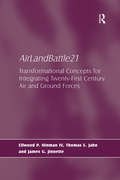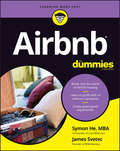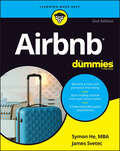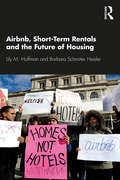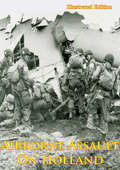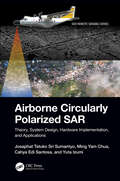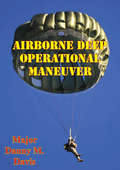- Table View
- List View
AirFox (A): Embracing the Blockchain and an ICO
by Jeffrey J. Bussgang Nathaniel Schwalb Edward B. BerkCase
AirLandBattle21: Transformational Concepts for Integrating Twenty-First Century Air and Ground Forces
by Ellwood P. Iv Thomas E. JahnThe changed strategic landscape of the 21st century has driven a shift to more flexible, adaptable capabilities across the spectrum of conflict. Operations in Iraq and Afghanistan have demonstrated the validity of team warfare between air and land forces during open hostilities with an enemy. The time has come for innovative counter-air and counter-land concepts focused on medium- to large-scale conventional combat operations that will merge air and ground forces even more effectively into a single potent fighting force. Such is the focus of AirLandBattle21. A basic assumption in this study is that, during major combat operations, a relevant number of Brigade Combat Teams (BCTs) will conduct distributed operations in a non-linear, non-contiguous and geographically separated fashion. The study introduces a flexible counter-air framework that allows for the most efficient use of limited air assets and advocates only the necessary levels of air control in different areas across the theatre. The study also offers alternative views of strategic attack and explores the critical role tactical airlift will play in employing and sustaining the brigade combat team.
Airbnb
by Evan Richardson Joseph B. LassiterBrian Chesky, Joe Gebbia, and Nathan Blecharczyk, the three founders of Airbnb, an online private accommodation rental market, stared at each other across the kitchen table in their San Francisco apartment. It was March of 2009. A single sheet of paper sat on the table in front of them. The three founders were on the verge of finishing the three month program at YCombinator (YC), a business accelerator located in Mountain View, CA.
Airbnb (A)
by Benjamin Edelman Michael LucaAfter widely-publicized complaints of destructive guests and unreliable hosts, online apartment rental site Airbnb explores mechanisms to facilitate trust between guests and hosts. Flexible online reputation systems can collect and share information with ease, but Airbnb must decide which information guests and hosts should have to provide and how much flexibility each should have in selecting whom to do business with. A full-featured system could provide all the information users have been requesting, but would it be too complicated for routine use?
Airbnb During the Covid Pandemic: Stakeholder Capitalism Faces a Critical Test
by Benjamin C. Esty Allison M. CiechanoverAs the covid pandemic spread in early 2020, global travel ground to a halt. For Airbnb, the San Francisco-based platform for renting accommodations, the impact was both swift and severe as revenues plummeted more than 70% over the prior year. Responding to the sudden downturn was a challenge for CEO Brian Chesky and his leadership team because the firm had a adopted a stakeholder model with five key constituents: guests (renters), hosts (landlords), employees, communities and shareholders. While all five groups could benefit in the long-term if the firm succeeded, it was less clear how they should balance the potentially conflicting demands in the short-term particularly given the mounting losses. For example, in the face of travel restrictions, Airbnb could support guests by requiring hosts to refund deposits or could support hosts by allowing them to keep deposits. Similarly, should Airbnb use existing cash to maintain employment levels or downsize to protect capital providers? In the highly uncertain environment that existed in April 2020, Chesky and his team had to make many critical decisions with little precedent and limited information to guide them. As one of the first Silicon Valley "unicorns" to adopt a stakeholder business model, the world would be watching to see what they did, how they did it, and why.
Airbnb Emerges from the Pandemic: Lessons for Stakeholder Governance (B)
by Benjamin C. Esty Allison M. CiechanoverAs the COVID pandemic spread in early 2020, global travel ground to a halt. For Airbnb, the San Francisco-based platform for renting accommodations, the impact was both swift and severe as revenues plummeted more than 70% over the prior year. Responding to the sudden downturn was a challenge for CEO Brian Chesky and his leadership team because the firm had adopted a stakeholder model with five key constituents: guests (renters), hosts (landlords), employees, communities and shareholders. While all five groups could benefit in the long-term if the firm succeeded, it was less clear how they should balance the potentially conflicting demands in the short-term particularly given the mounting losses. For example, in the face of travel restrictions, Airbnb could support guests by requiring hosts to refund deposits or could support hosts by allowing them to keep deposits. Similarly, should Airbnb use existing cash to maintain employment levels or downsize to protect capital providers? In the highly uncertain environment that existed in April 2020, Chesky and his team had to make many critical decisions with little precedent and limited information to guide them. As one of the first Silicon Valley "unicorns" to adopt a stakeholder business model, the world would be watching to see what they did, how they did it, and why.
Airbnb For Dummies
by Symon He James SvetecMake extra money—and your guests extra happy—with Airbnb! You’ve got that spare tower, mansion, apartment, couch, or perhaps even treehouse (really—there are more than 2,400 treehouses listed on Airbnb). You’re a polite, clean, and tolerant host. And you want to make some money. Congratulations, you’re fully qualified to become part of the Airbnb revolution! Whether you’re looking to break into the business, or have already started and are researching ways of making your guests feel even more pampered as you grow your reputation and income, Airbnb for Dummies is the perfect venue for you. And this applies whether you currently own property or not! Sit back in your lounge recliner and let the owners and founders of Learnairbnb.com show you the ins and outs of the short-term rental boom that connects hosts with travelers looking for more economical and personal travel experiences across the world. Sip a refreshing drink as you learn how to manage the day-to-day—from maintaining listings to keeping things clean for your guests—and how to maximize and increase your profits. Make an attractive listing Perfect your pricing Profit without a property Create amazing guest experiences So, get hold of a copy, read it in your favorite spot, and watch as the money and excited guests beat a path to your door!
Airbnb For Dummies
by Symon He James SvetecTurn to the most-trusted guide to get started on your Airbnb adventure Airbnb For Dummies is here to help you prep your property and post your first listing on the wildly popular short-term rental site. Even if you don’t have a house, you can become an Airbnb host. A spare room at your place, a camper, a boat, a treehouse, a castle—you can turn just about anything into an Airbnb and earn additional income hosting guests. You can even offer tours around your hometown. This comprehensive resource helps you make your goals a reality, with details on how to get set up and navigate the platform and where to turn for info on local short-term rental rules, plus all the post-pandemic changes to travel and to Airbnb’s policies. Learn to attract adventurers from far and wide, with help from For Dummies experts. Decide whether becoming an Airbnb host is right for you Create an appealing listing on the Airbnb site and attract guests Host experiences and ensure the health and safety of guests Get positive reviews and improve your property’s visibilityThis book is especially for you, the first-time Airbnb host in need of a guide for creating a listing, keeping up a property, and attracting guests.
Airbnb Listing Hacks: The Complete Guide To Maximizing Your Bookings And Profits
by Alex WongAirbnb has become something of a phenomenon recently. Every day, in every town on the planet, homeowners are making money by renting out their spare rooms to travelers. But with more and more people catching on, it's becoming increasingly difficult to stand out from the crowd. <p><p> This new book, Airbnb Listing Hacks: The Complete Guide to Maximizing Your Bookings and Profits can make all the difference in helping you stand out. <p> Years of helping hosts to optimize their listings, along with all the techniques required for success and how to avoid the common mistakes most hosts make, are crammed into this informative asset.
Airbnb Secrets: Earn $5000 A Month Posting Your Pad
by Sebastian RitterLooking to make some extra cash by renting out that spare room? Or maybe you want to dive into a full-on investment property! Making money through property rentals has never been more accessible and this guide will tell you everything you need to know about how to get started, how to be successful, and how to set yourself apart from the rest.
Airbnb in Amsterdam (A)
by Emer Moloney Vincent Dessain Mitchell WeissIn February 2014, Amsterdam became the first city to issue new regulations specifically to allow home-sharing. Airbnb's Molly Turner, Global Head of Civic Partnerships; her colleagues at the San Francisco based home-sharing platform; and her counterparts in Amsterdam's city leadership now had to make the new rules function well. By the summer of 2014, the question of how exactly to do that remained unsettled. A Memorandum of Understanding (MOU) that Airbnb was negotiating with Amsterdam officials to supplement the new home-sharing rules was not materializing. Turner was hearing that the company's proposed commitments that spanned education on regulations, enforcement-assistance, and tax collection might not be enough to secure what would be Airbnb's broadest partnership with any city anywhere. Nanette Schippers was Amsterdam's Advisor on the Sharing Economy in its Innovation Office, and its lead at the negotiating table that summer. She was worried by the stand-still, too. A primary reason for the impasse in the negotiations was that Amsterdam wanted access to Airbnb's data in order to enforce the new laws more easily, while Airbnb sought to protect user privacy. For Airbnb, privacy, precedents and platform principles were at stake. For Amsterdam, it was a matter of making sure that the historic city did not become "Venice, or Florence, or 'Disneyland'"; that it wasn't overrun by visitors and that locals weren't crowded out. Could the two parties now find dry land?
Airbnb in Amsterdam (B)
by Emer Moloney Vincent Dessain Mitchell WeissIn December 2014, the City of Amsterdam and Airbnb announced an MOU to promote responsible home-sharing and to simplify the payment of tourist tax for hosts in the City. It was the most comprehensive agreement that Airbnb had with any city in the world. It's final provision read, "The parties trust that theirs will be a fruitful cooperation." However, both sides were uncertain about how the agreement would be received. Molly Turner, Airbnb's Global Head of Civic Partnership and Tanja de Coster, an Airbnb lawyer in Europe, were unsure how Airbnb's hosts would react. As were their Airbnb colleagues. Laila Frank, who had been an advisor to the Deputy Mayor in Amsterdam, heralded the reputational gains from the agreement for the city, "We were worldwide news. In that way it worked out really well." But she acknowledged that there were also skeptical points of view. "The only immediate result was the tax agreement, which we were really happy about. But the rest had to be proven."
Airbnb, Etsy, Uber: Acquiring the First Thousand Customers
by Thales S. Teixeira Morgan BrownBy 2016, two-sided online platforms (or marketplaces) were pervasive among the highest growing internet startups around. These marketplaces sought to match suppliers of assets for rent, physical products or services with customers demanding them. Among the most notable two-sided platforms in terms of their tremendous early growth were Airbnb, Etsy and Uber. They offered short-term property rentals, handcrafted goods, and car rides, respectively. As two-sided markets grew to scale, network effects kicked in as more consumers bred more suppliers and vice versa. But how did these platforms acquire their first customers, at the time when they had so few providers? How exactly did they go about acquiring their first thousand customers?
Airbnb, Etsy, Uber: Growing from One Thousand to One Million Customers
by Thales S. Teixeira Morgan BrownBy 2016, two-sided online platforms (or marketplaces) were pervasive among the highest growing internet startups around. These marketplaces sought to match suppliers of assets for rent, physical products or services with customers demanding them. Among the most notable two-sided platforms in terms of their tremendous early growth were Airbnb, Etsy and Uber. They offered short-term property rentals, handcrafted goods, and car rides, respectively. As two-sided markets grew to scale, network effects kicked in as more consumers bred more suppliers and vice versa. But how did these platforms ride the second wave of growth? How did they grow from one thousand to one million customers?
Airbnb, Short-Term Rentals and the Future of Housing
by Lily M. Hoffman Barbara Schmitter HeislerHow do Airbnb and short-term rentals affect housing and communities? Locating the origins and success of Airbnb in the conditions wrought by the 2008 financial crisis, the authors bring together a diverse body of literature and construct case studies of cities in the US, Australia and Germany to examine the struggles of local authorities to protect their housing and neighborhoods from the increasing professionalization and commercialization of Airbnb. The book argues that the most disruptive impact of Airbnb and short-term rentals has been on housing and neighborhoods in urban centers where housing markets are stressed. Despite its claims, Airbnb has revealed itself as platform capitalism, incentivizing speculation in residential housing. At the heart of this trajectory is its business model and control over access to data. In a first narrative, the authors discuss how Airbnb has institutionalized short-term rentals, consequently removing long-term rentals, contributing to rising rents and changing neighborhood milieus as visitors replace long-term residents. In a second narrative the authors trace the transformation of short-term rentals into a multibillion-dollar hybrid real estate sector promoting a variety of flexible tenure models. While these models provide more options for owners and investors, they have the potential to undermine housing security and exacerbate housing inequality. While the overall effects have been similar across countries and cities, depending on housing systems, local response has varied from less restrictive in Australia to increasingly restrictive in the United States and most restrictive in Germany. Although Airbnb has made some concessions, it has not given any city the data needed to efficiently enforce regulations, making for costly externalities. Written in a clear and direct style, this volume will appeal to students and scholars in Urban Studies, Urban Planning, Housing and Tourism Studies.
Airborne
by DiAnn MillsHeather Lawrence’s long-awaited vacation to Salzburg wasn’t supposed to go like this. Mere hours into the transatlantic flight, the Houston FBI agent is awakened when passengers begin exhibiting horrific symptoms of an unknown infection. As the virus quickly spreads and dozens of passengers fall ill, Heather fears she’s witnessing an epidemic similar to ones her estranged husband studies for a living - but this airborne contagion may have been deliberately released.
Airborne
by Ian GardnerCol. Ed Shames is that rare man who can call himself a true warrior. A member of Easy Company of Band of Brothers fame, Shames saw combat in some of the most ferocious battles of WW2. From jumping behind the lines of Normandy on D-Day with the 101st Airborne Division, to the near victory of Operation Market Garden, to the legendary stand at Bastogne during the Battle of the Bulge, Shames fought his way across Europe and into Germany itself.In Airborne Shames and writer Ian Gardiner (Tonight We Die as Men) tell the gripping true story of what it was like to be at the spear point of WW2 in Europe. Neither the book nor TV series of Band of Brothers ever showed the real Ed Shames. Although he started as a private, combat soon forged Shames into a tough and inspired leader who would win a battle field commission in Normandy. Seemingly to always be where the fighting was, his two goals were to prevail in each fight with the Germans, and to keep his men alive. "Shames, you are the meanest, roughest son of a bitch I've ever had to deal with. But you brought us home," was the highest compliment he received from one of his men.Even though he was wounded in the Ardennes, Ed Shames never stopped fighting until Germany surrendered and the war was won. He has never stopped being a warrior.
Airborne
by Tom ClancyThey are America's front lines--serving proudly in forward areas around the world. Representing the very best from the Army and Air Force, the Airborne Task Force is an unstoppable combination of manpower and firepower. Now, Tom Clancy examines this elite branch of our nation's armed forces. With pinpoint accuracy and a style more compelling than any fiction, the acclaimed author of Executive Orders delivers an fascinating account of the Airborne juggernaut--the people, the technology, and Airborne's mission in an ever-changing world... * Two Tom Clancy "mini-novels"--real world scenarios involving the airborne task force * Airborne's weapons of the 21st century, including the Javelin anti-tank missile, the fiber-optically guided N-LOS fire support system, and the Joint Strike Fighter * 18 weeks: Life in an Airborne Alert Brigade * Exclusive photographs, illustrations, and diagrams PLUS: An in-depth interview with the incoming commander of the 18th Airborne Corps, General John Keen
Airborne Anti-Submarine Warfare: From the First World War to the Present Day
by Michael GlynnThis military history explores more than a century of aerial submarine hunting, from WWI through the Cold War and beyond. U. S. Navy veteran Michael Glynn served as a submarine hunting pilot. Now he chronicles the evolution of this unique combat role from the Great War through the Battle of the Atlantic in World War II and on to secret Cold War confrontations. He traces the parallel evolution of both aircraft and submarine as each side tries to gain advantage. Through his expert analysis, Glynn distills complicated oceanography, operations analysis, and technical theory, helping the reader understand how complex weapons and sensors function. He also examines submarine hunts in action, showing how theory and practice work together to help aviators detected their targets.
Airborne Assault On Holland [Illustrated Edition] (Wings At War #4)
by AnonIllustrated with 4 maps and 2 Illustrations.Airborne Assault on Holland highlights the role of air power as the Allies attempted to penetrate German defenses at the Siegfried Line. The work reflects the circumstances of the time and the desire to find good even in unfortunate circumstances and should be read with this in mind. Allied airborne paratroops and glider-borne units converged on Arnhem. Unfortunately, stiff German resistance forced their eventual withdrawal; Allied tactical air power prevented even heavier friendly losses, but could not turn defeat into victory. This boldly conceived operation involved the Eighth and Ninth Air Forces in a variety of missions: troop transport, fighter escort, flak neutralization, air cover, and resupply of ground forces.
Airborne Biocontaminants and their Impact on Human Health
by Rajeev Singh Anamika SinghExplore in-depth the relationships between biological contaminants and human health found in diverse settings such as homes, hospitals, businesses, and schools Indoor air quality has an immense impact on human health and well-being. Indoor air environments can contain a huge range of biological contaminants, including bacteria, fungi, viruses, insects, and their various harmful byproducts. Indoor biocontamination has been under-studied as an aspect of public and occupational health, and there is an urgent need for an introduction to this vital subject. Airborne Biocontaminants and Their Impact on Human Health meets this need with a thorough, rigorous overview of major indoor airborne contaminants. Gathering and summarizing a huge range of data regarding biocontaminants in settings from homes to schools to workplaces, it investigates patterns of morbidity and their connections to major contaminants. The result is an essential tool in the broader fight for human health at home and elsewhere. Airborne Biocontaminants and Their Impact on Human Health readers will also find: Analysis of the indoor role of gases, particulate matter, and others Detailed coverage of contaminant byproducts including endotoxins, mycotoxins, volatile organic compounds, and more Methods for generating awareness and therefore reduced risk of exposure to harmful contaminants Airborne Biocontaminants and Their Impact on Human Health is ideal for researchers—biologists, environmentalists, civil and environmental engineers, industrial hygienists, safety regulators, and public health officials—interested in the area of biological contamination in different environments.
Airborne Circularly Polarized SAR: Theory, System Design, Hardware Implementation, and Applications (SAR Remote Sensing)
by Josaphat Tetuko Sri Sumantyo Ming Yam Chua Cahya Edi Santosa Yuta IzumiA comprehensive resource on airborne synthetic aperture radar (SAR) systems, Airborne Circularly Polarized SAR explains the theory, system design, hardware and software, and applications of airborne circularly polarized SAR in environmental monitoring and other uses. Readers learn how to build the hardware and software of circularly polarized SAR, the antenna system, and how to generate point target responses and images using the range doppler algorithm (RDA) from raw signal data. The book discusses applications and analyzing techniques using a circularly polarized SAR system and image processing. Images and MATLAB® codes are provided to help professionals and researchers with their applications and future studies. Features 1. Provides the theory of circularly polarized wave and polarimetry related to system design, scattering analysis, polarimetric SAR, and applications in microwave remote sensing. 2. Explains the real radio frequency (RF) system and the original antenna, including circuit explanation and know-how of measurement technique to adjust to the required parameter in system design. 3. Discusses the technique of ground test and flight mission to calibrate and validate the performance of airborne circularly polarized SAR. 4. Highlights image signal processing with MATLAB codes and how to obtain a single look complex (SLC) image for further applications. 5. Includes several applications of airborne circularly polarized SAR from international leading experts. This book is beneficial to professionals, researchers, academics, and graduate students from disciplines such as Electronic Engineering; Radar Systems; Aerospace Engineering; Signal Processing; Image Processing; Environmental Remote Sensing.
Airborne Combat: The Glider War / Fighting Gliders of WWII (Stackpole Military History Series)
by James E MrazekStories of WWII&’s elite glider troops and their combat operations, including Eben Emael, Normandy, Bastogne during the Battle of the Bulge, and more. Long pursued by civilian thrill seekers and dare devils, airborne gliding came of age during World War II as one of that conflict&’s most dangerous combat operations. The armed forces of Axis and Allied nations developed gliders—wooden aircraft that bursts of flak could shred and a poor landing could smash—and flew them into battle at Eben Emael, Crete, Normandy, Arnhem, and Bastogne. James E. Mrazek&’s riveting account brings to life both the men who carried out these perilous missions and the gliders that proved vital to the success of airborne attacks.
Airborne Deep Operational Maneuver
by Major Danny M. DavisThe purpose of this paper is to answer two questions. The first question is: Is it feasible to use airborne forces to penetrate enemy airspace and to conduct a vertical envelopment to effect deep operational maneuver? If it is feasible, what are the employment options available for the use of such an airborne force in the conduct of a modern military campaign? To examine these questions, the paper begins with some definitions to provide a common frame of reference. The use of airborne forces in World War II is next examined to determine if the use of airborne forces to effect deep operational maneuver is historically feasible. Next, the contemporary threat is discussed as it is relevant to the employment of airborne forces in a modern context. Next, the feasibility of the use of airborne forces with some limitations to conduct deep operational maneuver is established in the context of the maneuver, firepower, and protection aspects of the combat power model. Next, the theory of deep operations and the use of airborne forces to conduct these kinds of deep maneuvers is examined in the theories of Clausewitz, Jomini, Tukhachevskiy, Triandafillov, and Simpkin. Next, six employment options for the use of airborne forces to conduct deep operations in a modern context are deduced. They are: (1) an airborne force can be used to create a second front within a theater of operations; (2) an airborne force can be used to operationally contain an enemy force targeted for destruction within a theater of operations; (3) an airborne force can be used to seize a "bridgehead"...; (4) an airborne force can conduct coups de main against high value targets within a theater of operations; (5) an airborne force can conduct light operations in a theater of operations to disrupt and disorganize the enemy's rear facilities and networks and have a cumulative operational impact; and (6) an airborne force can conduct expeditionary operations to achieve political, strategic, and operational aims
Airborne Dreams: "Nisei" Stewardesses and Pan American World Airways
by Christine YanoIn 1955 Pan American World Airways began recruiting Japanese American women to work as stewardesses on its Tokyo-bound flights and eventually its round-the-world flights as well. Based in Honolulu, these women were informally known as Pan Am's "Nisei"--second-generation Japanese Americans--even though not all of them were Japanese American or second-generation. They were ostensibly hired for their Japanese-language skills, but few spoke Japanese fluently. This absorbing account of Pan Am's "Nisei" stewardess program suggests that the Japanese American (and later other Asian and Asian American) stewardesses were meant to enhance the airline's image of exotic cosmopolitanism and worldliness. As its corporate archives demonstrate, Pan Am marketed itself as an iconic American company pioneering new frontiers of race, language, and culture. Christine R. Yano juxtaposes the airline's strategies and practices with the recollections of former "Nisei" flight attendants. In interviews with the author, these women proudly recall their experiences as young women who left home to travel the globe with Pan American World Airways, forging their own cosmopolitan identities in the process. Airborne Dreams is the story of an unusual personnel program implemented by an American corporation intent on expanding and dominating the nascent market for international air travel. That program reflected the Jet Age dreams of global mobility that excited postwar Americans, as well as the inequalities of gender, class, race, and ethnicity that constrained many of them.

